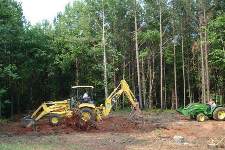I have a pole building in my backyard. Now I live on a lake, in the mountains. My lot is a parallelogram – 60’ x 225’ and 14 degrees out of square. From the lake, the back of my lot is probably 150 feet higher in elevation.
Hmmmm….grade change? Yes indeed, there is grade change and a lot of it.
My building is 40’ wide, in the direction the land slopes. Luckily, it is towards the crest of the hill, so the grade change there is only 12 feet. Yes, only 12 feet!
The solution was to excavate the hillside to create a level surface. 500 yards of earth removal later, we had this part handled.
Now – how to tackle placing a pole building on this site with a gigantic grade change? In our case, our engineer came up with using eight inch wide insulated foam blocks to form a 12 foot tall foundation on one side, and then stepping down across the 40 foot walls.
 Made of expanded polystyrene (EPS), the foam blocks are an insulating, stay-in-place formwork which sped construction and yielded a superior finished wall. In the most basic use of concrete in construction, the foam blocks accomplished in one step what normally requires numerous steps. It simultaneously acts as the forming system for placing concrete, the structural system for above and below grade walls, as superior stay-in-place insulation, sound suppression and as the substrate for exterior and interior finishing materials.
Made of expanded polystyrene (EPS), the foam blocks are an insulating, stay-in-place formwork which sped construction and yielded a superior finished wall. In the most basic use of concrete in construction, the foam blocks accomplished in one step what normally requires numerous steps. It simultaneously acts as the forming system for placing concrete, the structural system for above and below grade walls, as superior stay-in-place insulation, sound suppression and as the substrate for exterior and interior finishing materials.
The building process is simple: stack the block, lay rebar, brace the wall and pour concrete.
In my case, the building was built to follow the 14 degree out of square property lines! The only tools required for this special design was a handsaw and a tape measure.
Stuccos, waterproofing, drywall, siding and other finishes can be applied directly to the foam surface, allowing the complete range of design options available with traditional building techniques.
As for the finished structure, the forms combine the strength and safety of concrete walls with the high quality insulation of EPS foam, yielding a pole building which is safer, sounder and stronger.
And just a word about the environment; these EPS blocks do not utilize CFCs (chlorofluoro-carbon) in any step of production. For those who wonder what CFC’s “do” – they create ozone depletion, which equates to an environmental hazard. Lumber use (and expense) during construction was dramatically reduced, and any lumber used for bracing was re-used on other parts of the job.
Poured into the top of the EPS block walls, are Sturdi-Wall Plus wet set brackets, to attach the building columns to the top of the wall.
Obviously, we could also have solved the grade change problem by using poured concrete walls. However we felt the EPS system provided advantages not offered by a solid concrete wall. Fifteen years later, and not a problem to be found, which convinces me I made the right choice in using foam blocks.
Pole buildings offer so many unique advantages to other forms of construction. The design solutions are often only limited by your imagination!






